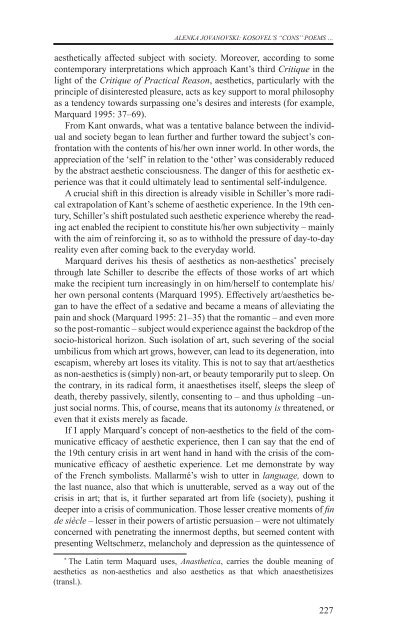razprave (pdf) - Društvo za primerjalno književnost - ZRC SAZU
razprave (pdf) - Društvo za primerjalno književnost - ZRC SAZU
razprave (pdf) - Društvo za primerjalno književnost - ZRC SAZU
- No tags were found...
You also want an ePaper? Increase the reach of your titles
YUMPU automatically turns print PDFs into web optimized ePapers that Google loves.
alenka jovanovski: Kosovel’s “Cons” Poems …aesthetically affected subject with society. Moreover, according to somecontemporary interpretations which approach Kant’s third Critique in thelight of the Critique of Practical Reason, aesthetics, particularly with theprinciple of disinterested pleasure, acts as key support to moral philosophyas a tendency towards surpassing one’s desires and interests (for example,Marquard 1995: 37–69).From Kant onwards, what was a tentative balance between the individualand society began to lean further and further toward the subject’s confrontationwith the contents of his/her own inner world. In other words, theappreciation of the ‘self’ in relation to the ‘other’ was considerably reducedby the abstract aesthetic consciousness. The danger of this for aesthetic experiencewas that it could ultimately lead to sentimental self-indulgence.A crucial shift in this direction is already visible in Schiller’s more radicalextrapolation of Kant’s scheme of aesthetic experience. In the 19th century,Schiller’s shift postulated such aesthetic experience whereby the readingact enabled the recipient to constitute his/her own subjectivity – mainlywith the aim of reinforcing it, so as to withhold the pressure of day-to-dayreality even after coming back to the everyday world.Marquard derives his thesis of aesthetics as non-aesthetics * preciselythrough late Schiller to describe the effects of those works of art whichmake the recipient turn increasingly in on him/herself to contemplate his/her own personal contents (Marquard 1995). Effectively art/aesthetics beganto have the effect of a sedative and became a means of alleviating thepain and shock (Marquard 1995: 21–35) that the romantic – and even moreso the post-romantic – subject would experience against the backdrop of thesocio-historical horizon. Such isolation of art, such severing of the socialumbilicus from which art grows, however, can lead to its degeneration, intoescapism, whereby art loses its vitality. This is not to say that art/aestheticsas non-aesthetics is (simply) non-art, or beauty temporarily put to sleep. Onthe contrary, in its radical form, it anaesthetises itself, sleeps the sleep ofdeath, thereby passively, silently, consenting to – and thus upholding –unjustsocial norms. This, of course, means that its autonomy is threatened, oreven that it exists merely as facade.If I apply Marquard’s concept of non-aesthetics to the field of the communicativeefficacy of aesthetic experience, then I can say that the end ofthe 19th century crisis in art went hand in hand with the crisis of the communicativeefficacy of aesthetic experience. Let me demonstrate by wayof the French symbolists. Mallarmé’s wish to utter in language, down tothe last nuance, also that which is unutterable, served as a way out of thecrisis in art; that is, it further separated art from life (society), pushing itdeeper into a crisis of communication. Those lesser creative moments of finde siècle – lesser in their powers of artistic persuasion – were not ultimatelyconcerned with penetrating the innermost depths, but seemed content withpresenting Weltschmerz, melancholy and depression as the quintessence of*The Latin term Maquard uses, Anasthetica, carries the double meaning ofaesthetics as non-aesthetics and also aesthetics as that which anaesthetisizes(transl.).227
















